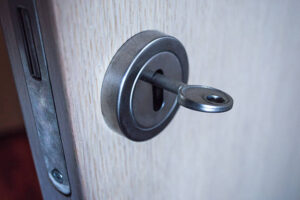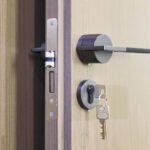The Real Cost and Budget Tips for High-Security Locks
Ever had that nagging feeling you left the door unlocked? Investing in high security door locks can turn that anxiety into a thing of the past. But, let’s be real—these bad boys aren’t cheap. So, what’s the damage to your wallet?
First off, let’s talk numbers. Basic locks are like paper towels; they get the job done but don’t expect miracles. On average, high-security locks will set you back anywhere from $100 to $500 per lock. Yes, that’s quite a leap from your standard hardware store variety.
Now before you clutch your pearls at those figures, think about what you’re really paying for here—peace of mind is priceless! These aren’t just any old locks; they’re Fort Knox-level stuff designed to keep even Houdini out.
So how do these prices break down? Material costs are one part of it. You’re looking at hardened steel or brass components built to withstand more than just a casual kick-in attempt. Then there’s technology involved—think drill-resistant cylinders and anti-pick pins.
But wait! There’s more (cue infomercial voice). Installation isn’t something you want to DIY unless you’ve got locksmith skills hidden up your sleeve. Professional installation might run another $50-$200 depending on complexity and labor rates in your area.

Alrighty then, now we know this isn’t going to be pocket change—but it’s not all doom and gloom either! Let’s chat budgeting tips so you don’t end up eating ramen noodles for months after upgrading:
1) Prioritize Your Needs: Not every door needs Fort Knox-level protection right away. Start with entry points like front doors or garage entries where intrusions are most likely.
2) Shop Around: Don’t settle on the first price tag that makes your eyes water! Compare different brands and models online before making a decision.
3) Look For Deals: Keep an eye out for seasonal sales or promotions from local locksmiths who might offer package deals.
4) DIY Prep Work: If possible, prep the installation site yourself by removing old hardware beforehand which could save some bucks on labor costs.
5) Long-Term Savings: Think long-term here—a quality lock reduces chances of break-ins which means fewer losses down line plus potential insurance discounts!
Let’s sprinkle in some real-life anecdotes too because why not? My buddy Jake once tried saving money by installing his own high-security lock… ended up locking himself out twice during “testing phases.” Long story short: he finally called a pro who fixed everything within half-hour flat—and charged less than expected!
On another note—you ever notice how burglars always seem smarter in movies? They pick simple locks faster than I can find my keys each morning! Reality check though—they’re often deterred by visible signs of strong security measures such as reinforced deadbolts & strike plates along with smart surveillance systems complementing physical barriers nicely!
But let’s not forget the importance of maintenance. High-security locks, like any sophisticated gadget, need a bit of TLC to keep them functioning smoothly. Regularly lubricate the lock mechanism and check for wear and tear. This ensures longevity and optimal performance.
Prepping for High-Security Lock Installation
Upgrading to high security door locks can feel like gearing up for battle. It’s all about turning your home into a fortress that even the most cunning intruder would think twice before attempting to breach. But hold your horses! Before you go all in, there’s some groundwork needed.
First off, take a good look at your doors. Are they sturdy enough? If they’re flimsy or showing signs of wear and tear, it might be time to consider replacing them with something more robust. A high-security lock is only as strong as the door it’s attached to—like putting a steel padlock on a cardboard box.
Now, let’s talk about deadbolts and strike plates. The average Joe might overlook these details, but not you—you’re aiming for Fort Knox-level security here! Ensure (oops!) Make sure you’ve got reinforced strike plates installed with long screws that anchor deep into the frame of the house. This adds an extra layer of defense against any brute force attempts.
While you’re at it, don’t forget about those hinges either! Hinges are often overlooked yet critical components when securing doors properly. Use hinge bolts or security studs if your door swings outward; this prevents someone from simply popping out the pins and removing the entire door.
Got windows near your doors? That’s another weak spot needing attention before installing high-security locks. Consider adding shatterproof film or even bars if you’re feeling particularly cautious—or paranoid!
Ever heard of bump keys? They’re tools burglars use to unlock standard pin tumbler locks without breaking a sweat—sneaky devils! Investing in bump-proof technology will put an end once-and-for-all stop such nefarious tactics right there on their tracks.
One more thing: measure twice cut once applies here too folks—not literally cutting anything hopefully—but double-checking measurements never hurt anyone did they now? You want precision fitment because gaps mean vulnerabilities which translates directly into risks we absolutely don’t need hanging around our precious abodes do we?
Absolutely not! So, grab that measuring tape and get accurate dimensions for your new high-security locks. Nothing worse than finding out your shiny new lock doesn’t fit properly.
Next up, consider the installation process itself. Are you a DIY enthusiast or more of a “call-the-pros” type? If you’re handy with tools and confident in your skills, go ahead—installing these locks can be a satisfying weekend project. But if the idea of drilling into your door gives you cold sweats, it might be wise to hire a professional locksmith. After all, they’ve got the expertise to install everything correctly without any hiccups.
Let’s not forget about maintenance either. High-security locks are like fine-tuned machines—they need occasional TLC to keep functioning smoothly. Regularly check for signs of wear and tear; lubricate moving parts with graphite powder (not oil!) to avoid gumming up the works.
And hey, while we’re on this security kick: think about adding some extra layers of protection beyond just locks. Motion-sensor lights around entry points can deter would-be intruders faster than you can say “Who’s there?” A video doorbell lets you see who’s knocking before opening up—talk about peace of mind!
Lastly but crucially: communicate! Let everyone in your household know how these newfangled contraptions work so nobody gets locked out accidentally—or worse yet—inadvertently compromises security by leaving doors ajar because they couldn’t figure things out properly themselves now could they?






